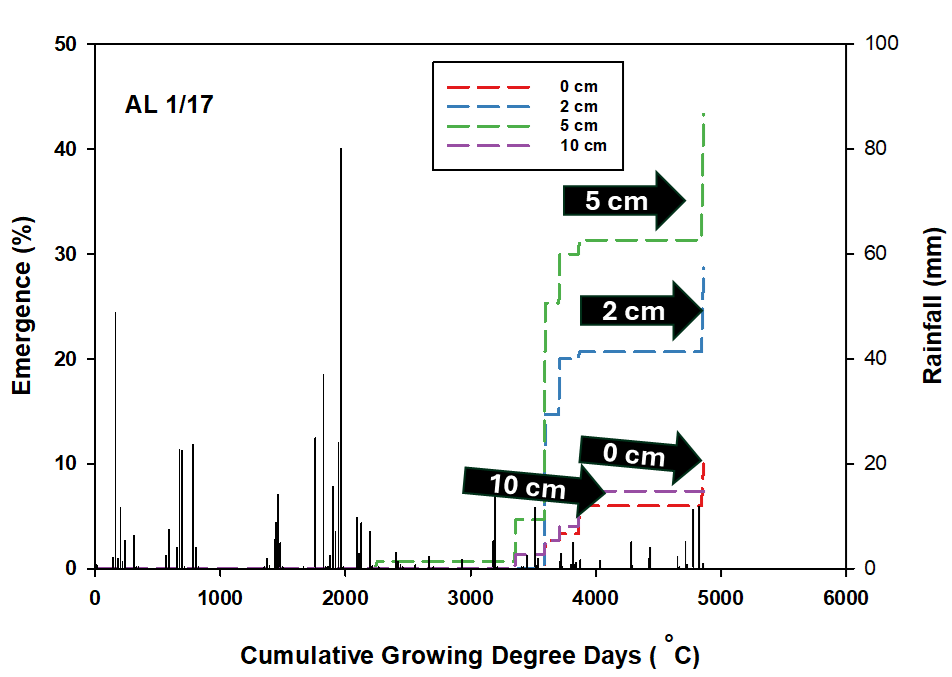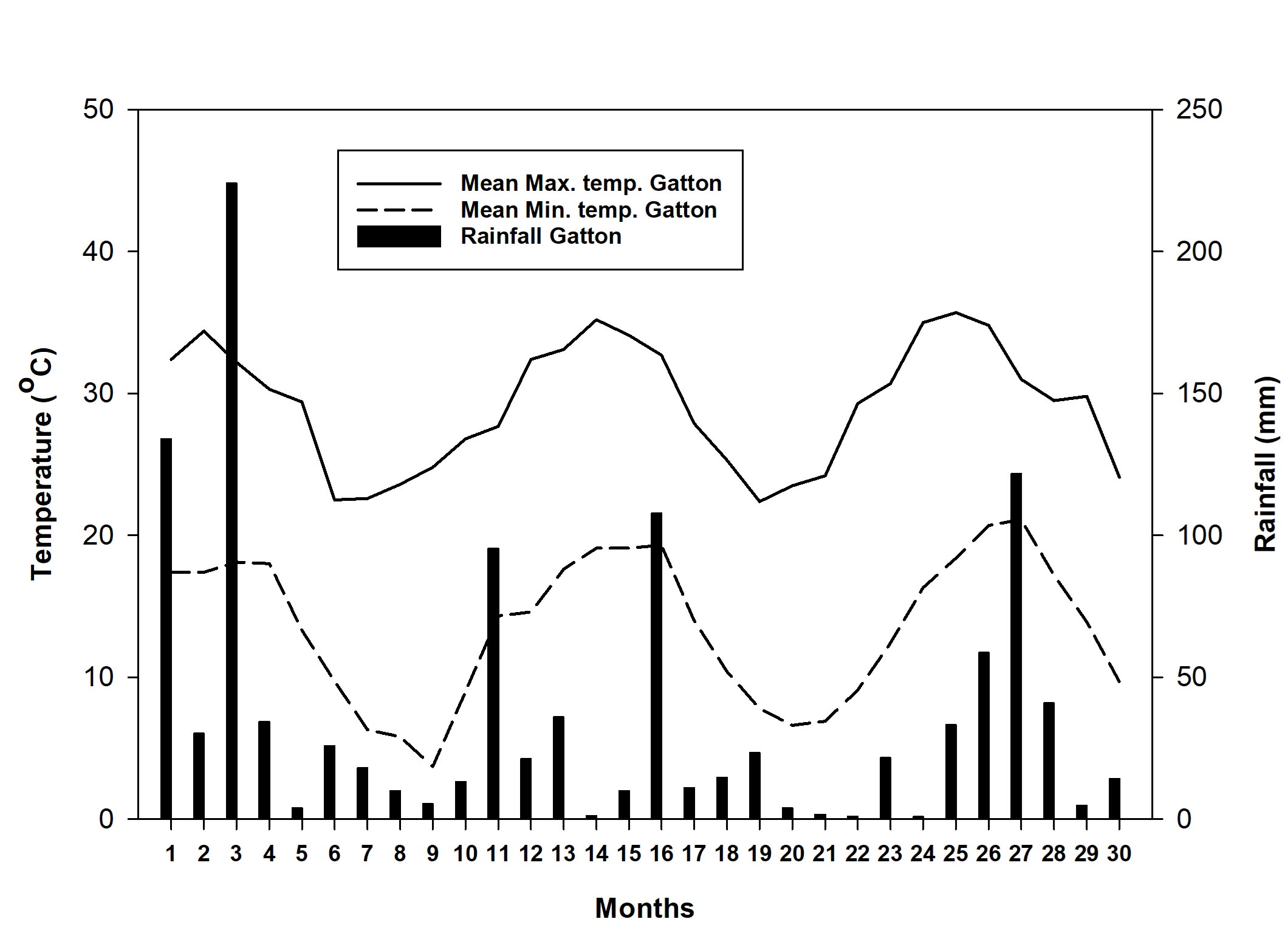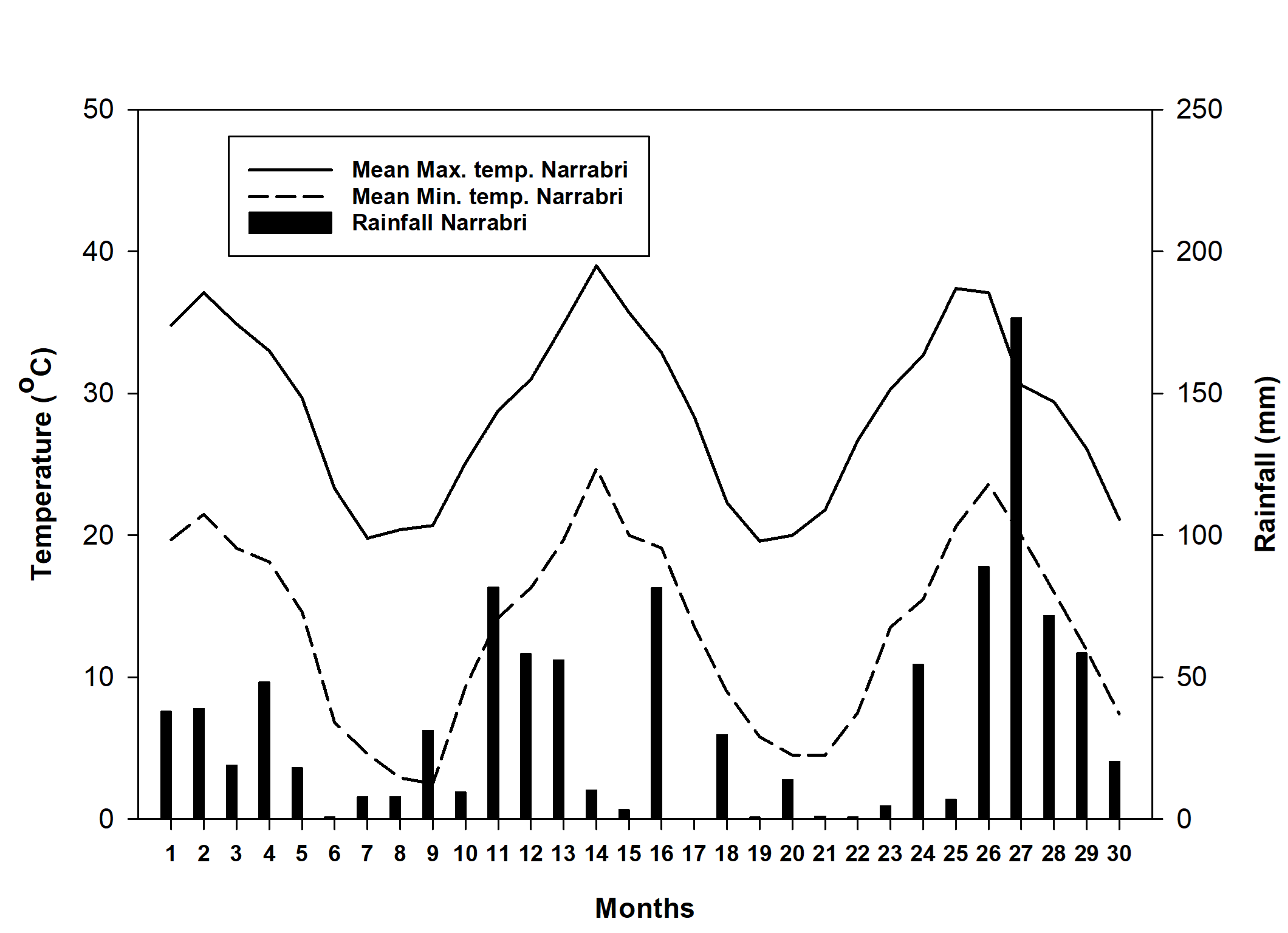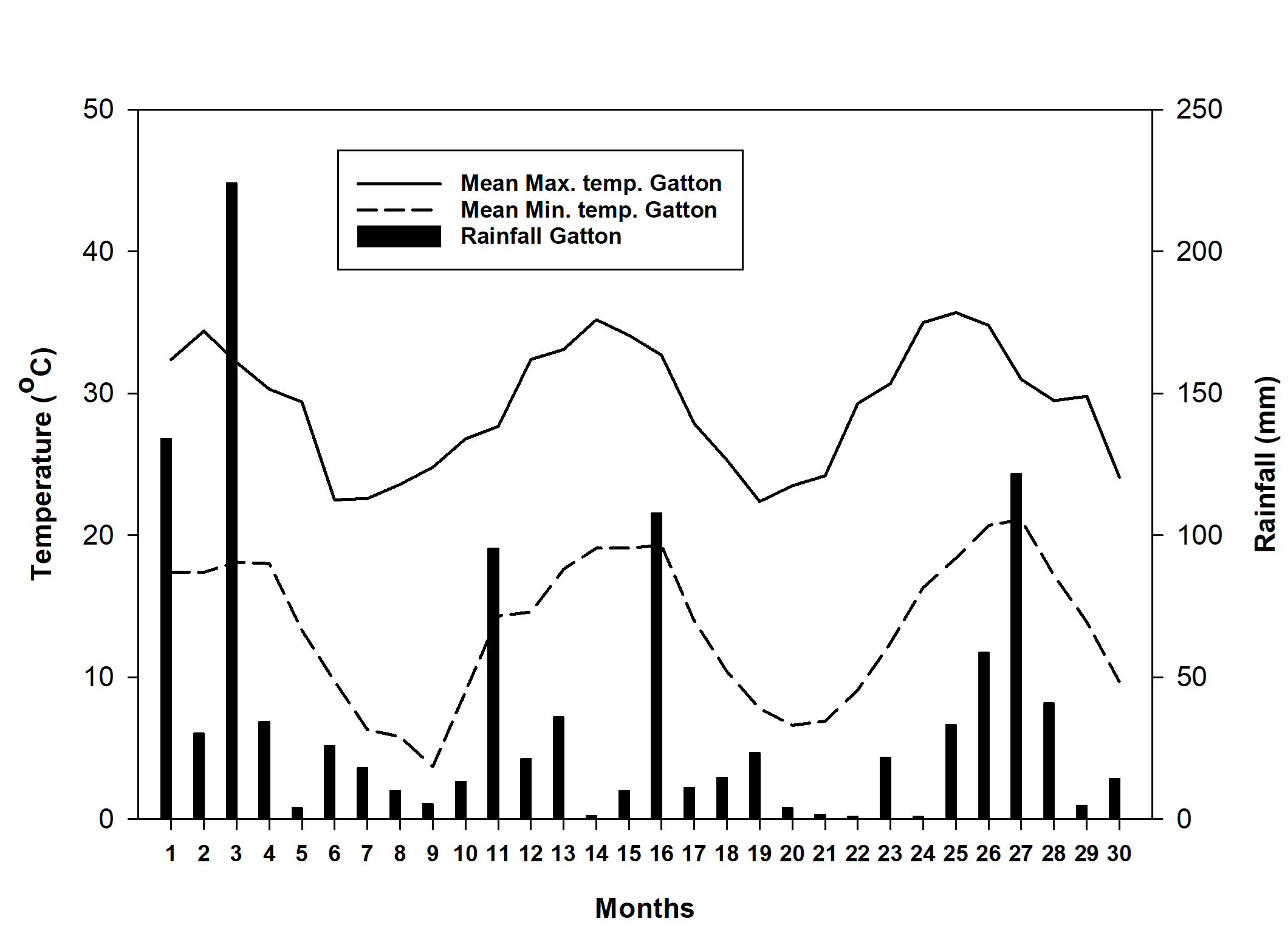Ecology and management of wild oat (Avena sterilis ssp. ludoviciana) in the northern grain region
Ecology and management of wild oat (Avena sterilis ssp. ludoviciana) in the northern grain region
Author: Gulshan Mahajan (UQ), Bhagirath Singh Chauhan (UQ) | Date: 04 Mar 2025
Take home message
- Wild oat exhibits staggered germination patterns from March to October, peaking in May and June
- Wild oat seed buried at shallow depth (2 cm) decay more slowly than at greater depths (10 cm) and on the surface, though the seed bank generally lasts less than two years
- Early establishing cohorts of wild oat can produce about 4,000 seeds/plant in a fallow situation
- Wild oat can produce seeds even under water stress conditions, making them resilient to drought
- Adopting Integrated Weed Management (IWM) practices, including crop competition through adjusted sowing time, increased seeding rate, harvest weed seed control, and reducing weed seed spread, can ensure effective and sustainable control when used in combination with effective herbicide strategies.
Background
Wild oat (predominantly Avena sterilis ssp. ludoviciana) is the most problematic winter weed in wheat, barley and chickpea crops grown in northern NSW and southern Qld. Its prolific seed production, staggered germination pattern and ability to adapt to environmental conditions make it a constant threat to agricultural productivity. Understanding its germination and emergence behaviour is critical for developing effective control strategies. Further, wild oat seeds may have persistent seed banks depending upon burial depth and replenishment if seed-set prevention strategies are not implemented.
The management of wild oat has become complicated after it has evolved resistance to herbicides, particularly Group 1 (ACCase inhibitors) and Group 2 (ALS inhibitors) herbicides, which are commonly used in Australian cropping systems. Over-reliance on chemical control options has contributed to resistance evolution, underscoring the need for an integrated weed management (IWM) approach.
The competitive ability of wild oat from its early emergence and rapid growth can lead to significant yield losses in winter crops. Yield losses in wheat can exceed 70% with an infestation of 50 plants m-2, necessitating effective control measures (Mahajan and Chauhan 2021a). It was hypothesised that integrating ecological, chemical, and cultural weed control practices, such as crop competition, altered sowing times, and increased seeding rates can provide effective wild oat control and reduce its impact on crops. To optimise interventions, this requires understanding weed biology, including emergence patterns, seed bank dynamics, and water stress behaviour.
Our research focused on the following objectives:
- Understanding the germination and emergence patterns of wild oat in the field.
- Investigating the impact of seed burial depth on seed persistence and decay rates.
- Evaluating the interaction between herbicide strategies and crop competition (not reported in this paper)
- Evaluating the effectiveness of crop competition and integrated management practices to control wild oat.
By exploring these aspects, we aim to provide insights into sustainable management strategies to mitigate wild oat infestations in the northern grain region cropping systems.
Methodology
Germination and emergence patterns
The effect of seed burial depth on seedling emergence of wild oat was studied at the Research Farm of the University of Queensland, Gatton, using fresh seeds of wild oat. Seeds were collected from a no-till chickpea–fallow field located near Warialda in eastern Australia (29.6075°S, 150.6888°E). The seeds were obtained from mature plants and were carefully identified based on their characteristic trait of shattering in pairs, confirming them as Ludo seeds. For this study, 50 seeds were placed in three replicates at different soil depths (0, 2, 5, and 10 cm) at the time of their natural seed shedding (November 2017). Seedlings were counted at 7-day intervals during the summer fallow and in the subsequent winter season. Emerged seedlings were killed using a non-selective herbicide after counting. Daily air temperatures and rainfall were recorded at the field site throughout the emergence period. Emergence data were recorded for 2 years from November 2017 to November 2019.
Impact of seed burial depth on seed persistence and decay rates
The experiment was conducted in controlled field microplots to examine the effects of burial depth on seed persistence and decay. The study was started in November 2017 and concluded in May 2020. Seeds (50) of wild oat were placed in nylon bags and buried at three depths: 0, 2, and 10 cm at three locations (Gatton, QLD; Narrabri, NSW, and St George, QLD). Bags were exhumed at six-month intervals over two years. Seeds were retrieved, and their viability and decay rates were assessed using a germination test under controlled conditions (20 °C day/10 °C night). During the period of the nylon bag study, Gatton, Narrabri, and St George received a total rainfall of 1,122, 1,038, and 710 mm, respectively (Appendix 1). To estimate 50 and 90% decay, data were regressed into two-parameter exponential decay model.
Impact of water stress on weed seed production
The experiment was conducted in a randomised complete block design with five soil moisture levels (100%, 80%, 60%, 40%, and 20% of water holding capacity) to simulate varying water stress levels. Treatments were replicated eight times in a factorial arrangement using 40 pots (7.5 L volume) filled with a soil mixture (2:1 ratio of field soil and potting mix) to enhance aeration and moisture retention.
Four seeds were sown in each pot and thinned to one plant after establishment. Water stress treatments were imposed 44 days after planting and maintained by weighing pots and adding water every alternate day. At harvest, seeds were counted. Data were analysed using ANOVA with a statistical significance set at P<0.05.
Phenology of wild oats under fallow situations
A field experiment evaluated the phenological behaviour of wild oat in fallow conditions in 2020. Plants were sown at different times (1 May, 1 June, 1 July, and 1 August). Six plants were planted in a plot of 1 m2 replicated thrice. At maturity time, days taken to maturity, seed head per plant and seed number per plant were recorded. Plant biomass was also assessed at harvest. Data were analysed using ANOVA with a statistical significance set at P<0.05.
Results and discussion
Influence of burial depth on emergence patterns
The emergence pattern of wild oat varied across burial depths when assessed with respect to cumulative growing degree days (GDD), highlighting this weed has adaptive characteristics and ecological plasticity (Figure 1). From a 5 cm depth, emergence began as early as March 2018 (2250 GDD) following significant rainfall events, suggesting that sufficient soil moisture during autumn can stimulate germination (Figure 1). In contrast, no emergence was observed from the surface, 2 cm or 10cm depths at this time, likely due to unfavourable environmental extremes or limited gas exchange at the 10-cm depth. Peak emergence occurred between May and June 2018 (3360–3720 GDD) and again in October 2018 (4860 GDD), indicating two major cohorts aligned with seasonal rainfall and temperature patterns. The greatest cumulative emergence (about 45%) was recorded from the 5 cm depth, while surface and 10 cm depths had reduced germination and emergence due to seed exposure to environmental stress and potentially fatal germination.
The early emergence of wild oat from 5 cm during autumn suggests that this species could compete significantly with winter crops such as wheat, barley, and chickpeas, especially in wider row configurations where crop competition is reduced and infestation is high. These findings underline the importance of early-season management, including the use of non-selective herbicides or tillage, to target early cohorts before crop establishment. Additionally, the study demonstrates the potential benefit of no-till systems in reducing emergence from the surface while avoiding seed burial to shallow depths conducive to greater germination rates. A wider emergence window in response to favourable environmental conditions demonstrates wild oat's resilience, highlighting the need for IWM strategies. This study suggests that selective pre-and post-emergence herbicides, combined with agronomic practices tailored to specific burial depths and moisture conditions, are likely to be required to reduce seed bank persistence and mitigate the competitive impact of wild oat in autumn and winter cropping systems.

Figure 1. Emergence pattern of wild oat (AL 1/17) in relation to burial depth and cumulative growing degree-days from 23 November 2017 to 23 November 2019. Emergence (left axis) is the dashed lines, Rainfall (right axis) are the columns.
Influence of burial depth on seed persistence
The persistence of wild oat seeds in the soil was strongly influenced by burial depth and environmental conditions. Across all locations, 50% of the seeds decayed within six months of burial, regardless of depth (Table 1). However, deeper insights revealed site-specific differences. At Gatton, surface seeds decayed more rapidly, with 90% decay occurring within seven months possibly due to favourable aeration and higher microbial activity. In contrast, at St George and Narrabri, the decay rate was slower, with 90% decay taking 11 to 17 months, depending on burial depth. This slower decay at St George may be attributed to its higher soil clay content (47%), and low amount of rainfall (Appendix 1), which likely reduced oxygen availability, limiting microbial activity and enhancing seed longevity (Mahajan and Chauhan 2021b)
Table 1. Longevity of wild oat seeds at different locations in relation to burial depths. Data were subjected to two-parameter exponential decay model.
| Location | Depth | 50% seed decay | 90% seed decay |
|---|---|---|---|
| (cm) | (after-months) | (after-months) | |
| Gatton | 0 | 2 | 7 |
| 2 | 4 | 15 | |
| 10 | 4 | 12 | |
| Narrabri | 0 | 3 | 11 |
| 2 | 4 | 13 | |
| 10 | 4 | 13 | |
| St George | 0 | 3 | 11 |
| 2 | 5 | 17 | |
| 10 | 4 | 12 |
Interestingly, burial depth had minimal influence on seed persistence at Narrabri, where similar decay rates were observed at all depths, suggesting that soil properties and moisture conditions may override depth effects. While studies report wild oat seeds as relatively short-lived with a half-life of six months, environmental variability significantly impacts persistence (McGillion and Storrie 2006; Medd 1996) Higher clay-content soils, as at St George, may enhance seed survival by reducing microbial decay and germination triggers (Appendix 2).
This study suggests that effective management should focus on minimising seed production and employing no-till systems to leave seeds on the surface, promoting faster decay. Combined strategies, such as harvest weed seed control and IWM practices (no-till production systems and exploiting crop competition), can significantly reduce seed bank longevity, leading to effective control of wild oats within two years if fresh seed production is prevented. These findings highlight the importance of tailoring weed management to site-specific soil and climatic conditions.
Influence of water stress on seed production
In this study, wild oat continued to produce some seeds even at 40% water-holding capacity (WHC) (Table 2). This suggests that this weed can withstand water stress, making it resilient, even under drought conditions. Wild oat exhibited greater seed production at higher moisture levels (80% and 100% WHC), attributed to its increased leaf number and chlorophyll content (Sahil et al. 2020), which enhanced photosynthesis and biomass. These traits enable wild oats to optimise resource use, even in environments where other weeds struggle.
Wild oat ability to survive in drought and thrive under favourable moisture conditions suggests that it can expand its range, particularly in dryland systems of the northern grain region, which are projected to experience increased drought spells due to climate change.
Table 2. Seed heads per plant and seeds per plant of wild oat in relation to soil moisture levels.
| Parameters | Soil moisture levels (% water holding capacity) | ||||
|---|---|---|---|---|---|
| 20 | 40 | 60 | 80 | 100 | |
| Seed head (number/plant) | 0a | 4a | 17b | 19b | 20b |
| Seeds (number/plant) | 0a | 54b | 282c | 406c | 417d |
| Values denoted by different letters are significantly different at P<0.05 (LSD test). | |||||
Phenology of wild oat in a fallow situation
Wild oat took less time for maturity in July and August planting dates compared with May and June planting dates, with the later germinating plants being significantly smaller. Seed production was higher in May and June planting compared with July and August planting dates (Table 3). Seed retention of wild oat ranged from 60–90%. These results suggest that early cohorts of wild oat (May and June) are highly prolific in seed production.
Table 3. Phenology of wild oat without crop competition.
| Parameters
| Planting time | |||
|---|---|---|---|---|
| 1 May | 1 June | 1 July | 1 August | |
| Height (cm) | 173a | 168a | 107b | 93b |
| Biomass/plant | 213a | 198a | 39b | 37b |
| Days to maturity | 144a | 137b | 122c | 103d |
| Seed number/plant | 4060a | 3250a | 650b | 438b |
| Seed retention (%) | 79a | 90a | 61a | 91a |
| NS = nonsignificant; means denoted by different letters are significantly different at p < 0.05 (LSD test). | ||||
Integrated management practices in wheat
The interaction of crop planting dates and seeding rates significantly affected the seed production of wild oat. Averaged over a range of herbicide strategies (not shown in this paper), in both early- and late-planted wheat, a high seeding rate (200 seeds m-2) reduced weed seed production by 70% and 50%, respectively, compared to the recommended seeding rate (Table 4). At the recommended seeding rate (100 seeds m-2), weed seed production in late-planted wheat was lower (1600 seeds m−2) compared to early-planted wheat (2770 seeds m−2). These findings suggest that late planting substantially reduces the seed production of wild oat, likely due to the lower competitiveness of late cohorts of the weed. Interestingly, when a high seeding rate was used, the planting date did not significantly affect weed seed production, suggesting that crop density may play a more critical role than planting date in managing weed populations.
Table 4. The interaction effect of planting dates and wheat seeding rates on wild oat seed production (mean of 2020 and 2021 years), averaged over herbicide strategies (not shown in this paper).
| Seeding rate (seeds m-2) | Weed seed production (no. m-2) | |
|---|---|---|
| Sowing time | ||
| 7th May | 7th June | |
| 100 | 2770a | 1600b |
| 200 | 870c | 840c |
| Means denoted by different letters are significantly different at P<0.05 (LSD test). | ||
The results imply that late planting of wheat results in reduced wild oat seed production. However, to maximise crop yield, growers will seek to plant wheat ‘on time’. This will require the addition of effective pre-emergence herbicides in combination with high seeding rates to suppress wild oat growth and reduce weed seed production, leading to higher wheat yields.
Conclusions
Wild oat produced multiple cohorts from March to October, peaking in May and June. On the surface and at 10 cm burial depth, seed decay was faster compared with 2 and 5 cm burial depths. Physical properties of the soil (e.g., St George in our study) may influence the seed ecology of wild oat buried at shallow depths (e.g., 2 cm) and, consequently, seed bank dynamics in the agroecosystem. Regardless of depth, seed viability decreased significantly after 6 months of seed burial. Therefore, preventing seed bank replenishment in no-till systems (for 2 years) has the potential to eliminate this weed in a relatively short period of time.
Early season cohorts of wild oat produced more seeds than mid- and late-season cohorts. Therefore, it is essential to control early cohorts with suitable herbicides and correct timing to prevent early season wild oat establishment. Integrated crop management practices (manipulating sowing time and seed rate) that help in early canopy closure may suppress the late-season cohorts and reduce seed production. Seed retention values in this study suggest that further work should be investigated in understanding the potential value of harvest weed seed control as another integrated management tactic. Wild oat may adapt to climate change as it has a wider emergence time and produces sufficient seeds under water-stress conditions to survive.
References
McGillion T, Storrie A E (2006) Integrated Weed Management in Australian Cropping Systems—A Training Resource for Farm Advisors. Adelaide: CRC for Australian Weed Management. 314 p
Mahajan G, Chauhan BS (2023) Improving wheat productivity through integrated management of Avena ludoviciana. Agronomy Journal 115,1478–1488.
Mahajan G, Chauhan BS (2021a) Interference of wild oat (Avena fatua) and sterile oat (Avena sterilis ssp. ludoviciana) in wheat. Weed Science 69, 485–491.
Mahajan G, Chauhan BS (2021b) Seed longevity and seedling emergence behavior of Avena fatua and Avena ludoviciana in response to burial depth in eastern Australia. Weed Science 69, 362–371.
Medd RW (1996) Ecology of wild oats. Plant Prot Q 11(S1):185–187
Sahil, Mahajan G, Loura D, Raymont K, Chauhan BS (2020) Influence of soil moisture levels on the growth and reproductive behaviour of Avena fatua and Avena ludoviciana. Plos One, 15(7), e0234648, doi.org/10.1371/journal.pone.0234648
Additional/useful resources
Mahajan G, Chauhan BS (2023) Avena sterilis ssp. ludoviciana (Durieu) control in wheat through integration of tillage, seeding rate, and herbicide application. Gesunde Pflanzen 75, 2337–2344.
Mahajan G, Chauhan BS (2021) Biological traits of six sterile oat biotypes in response to planting time. Agronomy Journal, 113, 42–51.
Mahajan G, Chauhan BS (2021) Don’t sow wild oats (compiled by Cindy Benjamin).
Mahajan G, Chauhan BS (2023) Interference of sterile oat (Avena ludoviciana) and Mexican pricklepoppy (Argemone mexicana) in chickpea. Crop and Pasture Science 74, 1156–1164.
Mahajan G, Chauhan BS (2023) Herbicide options for sterile oats (Avena ludoviciana) control in winter-planted sorghum. Weed Technology 37, 95–99.
Mahajan G, Chauhan BS (2020) Using barley cultivar choice and herbicides for wild oat control. Australian Grain, November–December issue, p7-8.
Acknowledgements
The research undertaken as part of this project is made possible by the significant contributions of growers through both trial cooperation and the support of the GRDC, the authors would like to thank them for their continued support.
Contact details
Gulshan Mahajan (Research Fellow)
University of Queensland, Gatton, Queensland, Australia.
Ph: 0432467954 (Mobile)
Email: g.mahajan@uq.edu.au
Bhagirath Singh Chauhan (Professor)
University of Queensland, Gatton, Queensland, Australia.
Ph: 0427923272 (Mobile)
Email: b.chauhan@uq.edu.au
Date published
March 2025
®Registered trademark
Varieties displaying this symbol are protected under the Plant Breeders Rights Act 1994
| a) |  |
| b) |  |
| c) |  |
Appendix 1. Weather conditions at a) Gatton, b) Narrabri and c) St. George) during the nylon bag seed persistence study (starting from November 2017).
Appendix 2. Physical and chemical properties of soils at different locations.
| Location | Sand (%) | Silt (%) | Clay (%) | Organic carbon (%) | pH (CaCl2) | Conductivity (ds m-1) |
|---|---|---|---|---|---|---|
| Gatton | 30.9 | 25.0 | 44.1 | 1.30 | 6.7 | 0.28 |
| Narrabri | 46.6 | 13.4 | 40.0 | 0.58 | 7.0 | 0.32 |
| St. George | 39.5 | 13.3 | 47.2 | 0.47 | 7.5 | 0.32 |
GRDC Project Code: UOS1703-002RTX,
